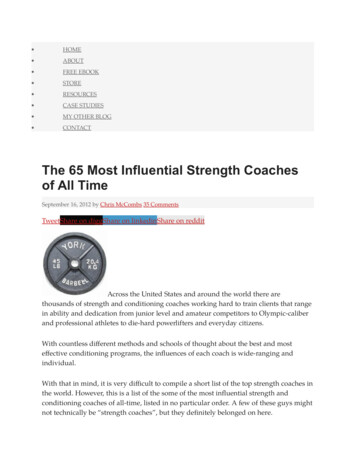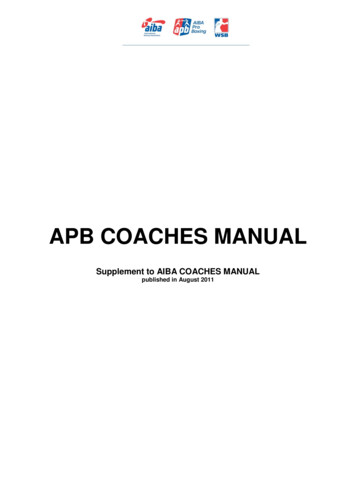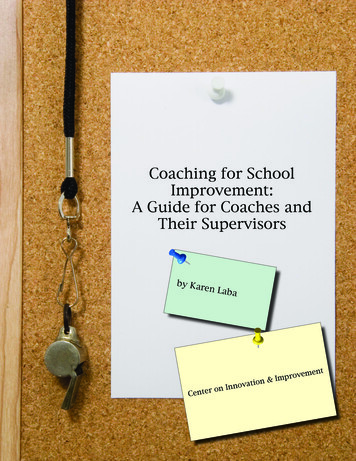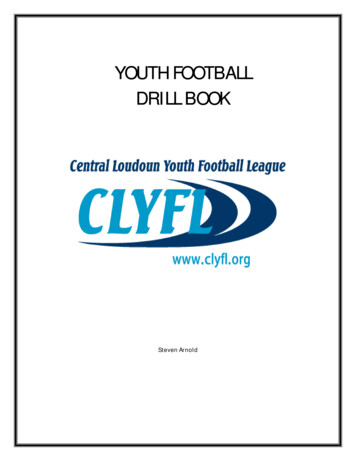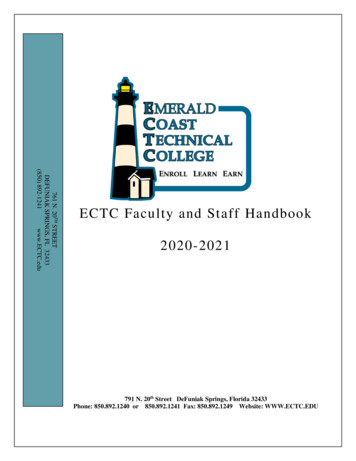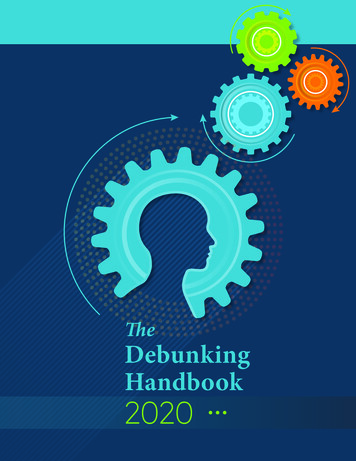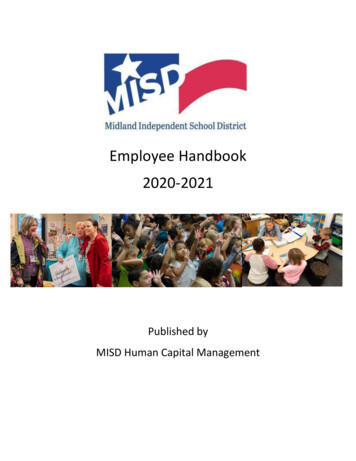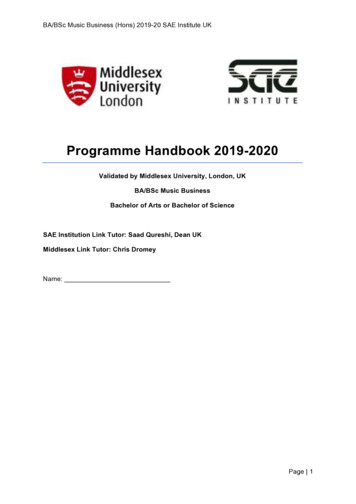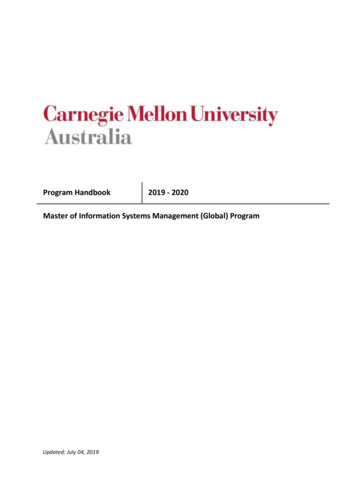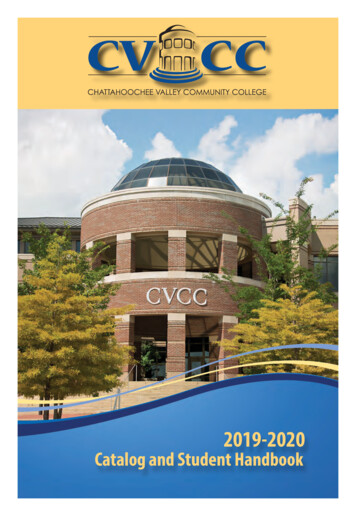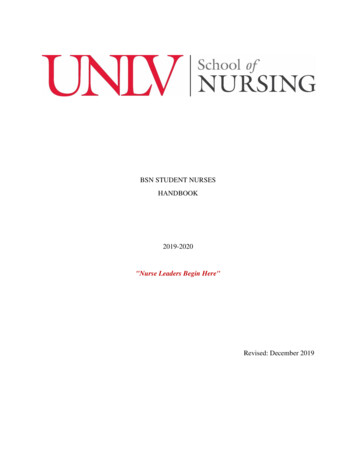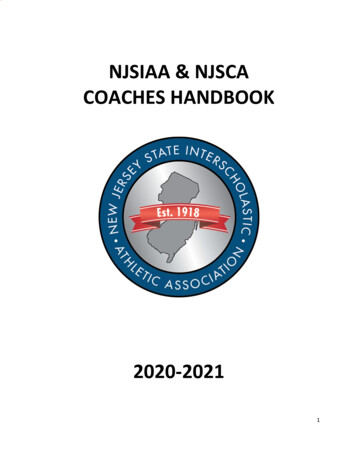
Transcription
NJSIAA & NJSCACOACHES HANDBOOK2020‐20211
ContentsMessage from NJSIAA Chief Operating Officer . 1COVID GUIDELINES. 2The Successful Coach . 11The Coach as a Role Model . 12Coaching Expectations and Responsibilities . 13Accreditation and Employment Issues . 18Sportsmanship . 19Disqualification of Coaches/Players . 22NJSIAA Steroids Policy. 27NJSIAA Drone Policy . 28Transgender Policy/FAQ . 28NJSIAA 2020‐2021 Banned Drugs . 31NJSIAA Mission Statement . 33Athlete Participation Limitations . 34Out of Season Guidelines . 34Guidelines for Thunder/Lightning Safety . 39Insurance Benefits . 41NJSIAA Concussion Policy . 45Pre‐Season Practice Guidelines for Fall Sports. 47Coaches Code of Ethics. 49Individual Membership Application . 50
Message from Colleen MaguireThe NJSIAA Chief Operating Officer“A good coach can change a game. A great coach can change a life.”-John WoodenOn behalf of the NJSIAA staff, I want to personally thank you for coaching our student-athletes. Given therecent circumstances surrounding the COVID-19 pandemic, your role is more important than ever before. Ourstudent-athletes need your support both on and off the field, court, track, etc. Their lifestyles changedovernight, their social and emotional well-being is at stake, and some may have lost the support of close familymembers during the pandemic.While the 2020 – 2021 school year is going to look different in many, many ways, each of you can help toprovide some normalcy for our student-athletes. While there may be less games played, less miles traveledand less championships to play for, you all can play a pivotal role in re-engaging our student-athletes andhelping them get through these uncertain times.We all have fond memories of our high school sports playing days. We should not let the COVID-19 pandemicinterfere with the opportunity to create experiences and memories that will last a lifetime for these studentathletes.The lessons you can teach your student-athletes this year have never been more valuable. You will help themlearn to deal with adversity, to be resilient in the face of obstacles, and to keep working hard no matter the odds.These are lifelong lessons that our student-athletes will take with them, and they will pay it forward to the nextgeneration of student-athletes.Best of luck during the upcoming school year.Kind regards,Colleen Maguire, Chief Operating Officer1
COVID GUIDELINESSportCross CountryField HockeyFootballGymnasticsSoccer – BoysSoccer – GirlsTennis – GirlsVolleyball – GirlsNJSIAA DirectorBill BrunoKim ColeJack DuBoisBill BrunoJack DuBoisAl StumpfTony MaselliAl StumpfState Rules InterpreterCarl RickershauserCharlotte HeenanBill SurdovelBarbara WallaceEd SeversEd SeversJim ForstSharon HughesCoaches Certifications 2020‐2021 Just for the 2020‐2021 School Year, New Coaches may take the on line version of theFundamentals of Coaching Course that can be found on the NFHS Learn site. CPR/AED Certifications MUST STILL BE IN PERSON! All coaches are to pay appropriateNJSIAA fees.DQ vs. Game Ejection Disqualification RuleAny student‐athlete or coach disqualified before, during or after an interscholastic event forunsportsmanlike, flagrant verbal or physical misconduct will be disqualified from the nexttwo regularly scheduled contests, except for football which will carry a one gamedisqualification. Game EjectionDefinition of a game ejection is any player removed from a game for behavior that is notconsidered unsportsmanlike, and does not require a DQ report to be filed.Handshake ‐ THERE WILL BE NO HANDSHAKES FOR THE 2020 FALL SEASON Coaches, officials are not required to supervise the handshake. It is the schools/coaches’ responsibility to supervise the handshake. Officials are permitted to observe the handshake if they desire.Heat Policy The heat policy and subsequent modifications is the decision of the school district. Theywill determine the correct procedure as spelled out in the heat policy. Officials are not involved in this decision regarding the heat policy before or during thegame. School district personnel should be in communication with all officials assigned to the gameregarding modifications if needed.2
School Uniform ModificationsTransgender Clarification:Pursuant to NJ law and NJSIAA policy, the NJSIAA will approve all reasonable accommodationsregarding uniforms as it relates to transgender student‐athletes. If there are any questionsregarding this on the day of the contest, officials are instructed to continue with the contest andnotify the NJSIAA the following day.All Accommodations: Must not violate the NFHS sports specific uniform rules.Must match the existing uniform in terms of color and logos.Must not create an unsafe environment for all participants.Religious Clarification:The NJSIAA will approve all reasonable accommodations regarding uniforms as it relates toaccommodations for religious reasons. Schools may modify uniforms for their athletes forreligious reasons upon approval of the NJSIAA. A copy of the letter from NJSIAA that allows suchmust accompany the participant at each event to be available for the official to review andapprove. If a letter from the NJSIAA is not available, officials are instructed to continue with thecontest and notify the NJSIAA the following day.All Accommodations: Must not violate the NFHS sport specific uniform rules.Must match the existing uniform in terms of color and logos.Must not create an unsafe environment for all participants.Jewelry Clarification: Jewelry shall not be worn except for religious or medical medals.A religious medal must be taped and worn under the uniform.A medical alert must be taped and may be visible.Any questions or concerns regarding uniform modifications, please contact the NJSIAA.Professional Development: Please visit the NFHSlearn.com for many free Professional development opportunities.Any NJSCA Coaches Clinics will be posted on the NJSIAA website.3
The following procedures should be in place before the start of summer workoutsStudent‐athletes who presently have COVID‐19, or who have tested positive for COVID‐19, shallprovide clearance from a physician before he/she will be permitted to participate in workouts.Student‐athletes who have pre‐existing medical conditions and/or are immunocompromised (e.g.,diabetes, asthma, auto‐immune disorders, etc.) shall provide clearance from a physician beforehe/she will be permitted to participate in workouts.All student‐athletes must have a COVID‐19 Questionnaire completed before the start of the firstworkout session. This form only needs to be completed one time. Any athlete that does nothave a COVID‐19 Questionnaire on file will not be permitted to participate in any workouts. Thequestionnaire must be kept on file in accordance with the district's normal procedure for collectingsuch forms.Districts shall develop COVID‐19 protocols and procedures detailing, among other things, the nameand contact information of the individual(s) who will be primarily responsible for responding to andaddressing COVID‐19 related issues; how it will conduct screenings (including administration of ascreening questionnaire and temperate checks); how it will respond to a positive COVID‐19 test ora student‐athlete or coach who is symptomatic including, without limitation, contact tracing and acommunication plan with parents, student‐athletes, coaches, and appropriate health authorities.Districts shall examine their Emergency Action Plans and determine what changes, if any, may beneeded to respond to emergencies, including those related to COVID‐19.Districts shall determine how they will handle and respond to the routine treatment and care ofstudent‐athletes who may be injured during workouts, including both on the field and in thetraining room.Because the prevalence of COVID‐19 varies by state, and New Jersey’s numbers are declining whilenumbers from other states are rising, the Governor has issued an incoming travel advisory that allindividuals entering New Jersey from states with a significant spread of COVID‐19 shouldquarantine for 14‐days after leaving that state. If a student‐athlete chooses to travel to one ofthe “hot spot” states, the district administration should advise the student‐athlete that he/shecannot return to workouts until after a fourteen (14) day period of quarantine has been observed.The link below will provide you with the most up to date list of “hot spot” ‐restrictions‐to‐or‐from‐new‐jerseyThe following NJSIAA guidelines are set at a minimum level. School districts out of anabundance of caution may choose to exceed the NJSIAA guidelines, which is their decision andabsolutely acceptable by the NJSIAA.4
General Guidelines for all PhasesRationaleThe NJSIAA summer recess period will run from Monday, July 13th, through Friday, August28th. Participation in the summer recess period is optional and districts may choose which date tostart. Summer recess workouts will run according to the guidelines issued by NJSIAA and the MedicalAdvisory Task Force. All schools participating in the summer workouts must start with the Phase 1guidelines regardless of the start date. Each Phase must be completed to advance to the next Phase.The Medical Advisory Task Force guidelines are only applicable to the summer recess period. Once regularseason practices commence on September 14, all practices will be run in accordance with local schooldistrict policies. Additional information regarding the conducting of safe regular‐season practices may alsobe forthcoming from NJSIAA as well. The Medical Advisory Task Force guidelines are consistent withresearch‐based best practices used throughout the country at all levels of competition including both theprofessional and collegiate levels.Note: Only a Doctor of Osteopathic Medicine (DO) or a Doctor of Medicine (MD) can clear athletes forsummer workouts concerning COVID‐19 signs, symptoms, and history. It is the responsibility of the doctoror testing facility to notify the local agency of a positive test. The local agency will begin the contacttracing procedure.Screening1. Who can conduct the daily screening process?a. Each district must designate sufficient school personnel to conduct the daily screeningprocess.b. Any school‐approved employee may conduct the screening process.c. The screener does not have to be the same each day although it is strongly recommended.2. COVID‐19 Daily screening Questionsa. The COVID‐19 daily screening form is required before each workout.b. Student‐athletes must fill this form out before they arrive on site.c. If there is a “YES” answer on the form, students should not come to the workout until theyare cleared by a DO or MO.3. Responsibilities of the screenera. The screener must always wear a face covering.b. The screener must fill out the pre‐screening questionnaire for themselves and have theirtemperature checked.c. The screener must confirm that all coaches are wearing face coverings and have acompleted pre‐screening questionnaire in hand, or they will not be screened.d. The screener must not start the screening process until the coach has arrived and beencleared.e. The screener must confirm that all student‐athletes must be wearing face coverings andhave a completed pre‐screening questionnaire, or they will not be screened.f. The screeners must confirm that the student‐athlete answered “NO” to all the screeningquestions and take the temperature of the student‐athletes one at a time.5
g. The screener only needs to document the temperature on the pre‐screening questionnaireif it is 100.4 or above.h. The screener must collect all completed documents and file them in accordance with thedistrict's normal procedure for collecting such forms.4. Can an assistant coach perform the screening if they are coaching on the same day?a. This is permissible only when there is more than one coach involved in coaching that day.There always needs to be at least one supervising coach that is not involved with thescreening process to supervise the student‐athletes. The supervising coach mustconcentrate on getting the student‐athletes in their 10‐person workout groups (pods) andmaking sure that student‐athletes adhere to social distancing requirements and are wearingface coverings.b. If there is only one coach, then there must be another district approved employee who canconduct the screenings.c. To the fullest extent possible, districts should consider staggered arrival and departuretimes of student‐athletes.d. Multiple screenings may take place at the same time and/or at different locations if thedistrict has the resources and personnel to do so and can ensure that all screeningprocedures are followed.5. The supervising coach's responsibility during the screening process.a. All coaches must always wear a face covering.b. The supervising coach needs to get the student‐athletes into their workout groups (pods),making sure the student‐athletes adhere to social distancing requirements (6 feet apart)and wearing face coverings.c. The student‐athletes must keep their face coverings on until the screening process iscompleted, and they are instructed to remove them by their supervising coach.6. Student‐athletes who have pre‐existing medical conditions and/or are immunocompromised (e.g.,diabetes, asthma, auto‐immune disorders, etc.) shall provide written clearance from a DO or MObefore he/she will be permitted to participate in workouts.a. Personnel conducting the screenings may or may not know the student‐athletes that havepre‐existing medical conditions; therefore, school districts shall notify all parents/guardiansthat student‐athletes with pre‐existing medical conditions should consult with a doctorbefore they are permitted to participate in the workouts.7. Procedure for anyone that arrives on‐site and has answered “YES” on the screening form or has atemp of 100.4 or above.a. Stop the screening process immediately.b. Separate the athlete from the rest and call the parent back. Parents must be instructed toremain at the drop‐off point until the athlete clears the screening process.c. The student‐athlete is not permitted to begin workouts until cleared by a DO or MO.d. If the supervising coach has answered “YES” or has a temp of 100.4 or above, then theworkout will be canceled, and the athletes should return home unless there are additionalcoaches.6
Procedural situations for student‐athletes & coaches regarding COVID‐19 contact1. A Student‐athlete who has come in contact with someone, including a family member, that hastested positive of COVID‐19a. Student‐athlete must self‐quarantine and contact their doctor for further instructions.b. A return‐to‐play note from a DO or MO must be completed before the student‐athlete mayreturn to workouts.c. The related pod will be permitted to continue until results are known of the quarantinedstudent‐athlete.d. All members of the related pod must be extremely vigilant in checking for signs orsymptoms multiple times a day.2. A Student‐athlete has signs or symptoms of COVID‐19a. Student‐athlete must self‐quarantine and contact their doctor for further instructions.b. A return‐to‐play note from a DO or MO must be completed before the student‐athlete mayreturn to workouts.c. The related pod will be permitted to continue until results are known of the symptomaticstudent‐athlete.d. All members of the related pod must be extremely vigilant in checking for signs orsymptoms multiple times a day.3. A Student‐athlete has tested positive for COVID‐19a. The student‐athlete must self‐quarantine and contact their doctor for further instructions.b. all members of the related pod must self‐quarantine and contact their doctor for furtherinstructions.c. A return‐to‐play note from a DO or MO must be completed before all student‐athletes ofthe related pod may return to workouts.4. A coach who has come in contact with someone, including a family member, that has tested positiveof COVID‐19a. The coach must self‐quarantine and contact their doctor for further instructions.b. A return‐to‐play note from a DO or MO must be completed before the coach may return toworkouts.c. The related pod will be permitted to continue until results are known of the quarantinedcoach.d. All members of the related team/pod must be extremely vigilant in checking for signs orsymptoms multiple times a day.5. A coach has signs or symptoms of COVID‐19a. The coach must self‐quarantine and contact their doctor for further instructions.b. A return‐to‐play note from a DO or MO must be completed before the coach may return toworkouts.c. The related pod will be permitted to continue until results are known of the symptomaticcoach.d. All members of the related team/pod must be extremely vigilant in checking for signs orsymptoms multiple times a day.7
6. A coach has tested positive for COVID‐19a. The coach must self‐quarantine and contact their doctor for further instructions.b. If the coach was not directly engaged in a particular pod, and just supervised workoutswhile maintaining proper social distances and wearing a mask, then the team and pod maycontinue if other coaches are available.c. If the coach was directly engaged in a particular pod, then all members of the related podmust self‐quarantine and contact their doctors for further instructions.d. A return‐to‐play note from a DO or MO must be completed for all coaches and student‐athletes that were forced to quarantine before they may return to workouts.Workouts1. Access to workouts must be limited to student‐athletes, coaches, and appropriate school personnel.2. Coaches must be mindful of practicing in the heat of summer. Proper hydration is essential. TheNJSIAA heat policy is always available on our website as a reference during the summer recessperiod.3. Coaches should have pre‐drawn structured workouts for the duration of the session.4. Hydration stations are not permitted during Phase 1 & 2. School districts should provide access tofluids in case of an emergency.5. During all workouts, coaches and staff are reminded to be alert for any students exhibiting signs ofdistress regarding mental health secondary to the COVID‐19 pandemic.6. In case of inclement weather, each school district will need to monitor and be ahead of bad weatherto the best of their ability. Altering workout times because of potential bad weather is stronglyencouraged. School districts should also have a plan in place for safe evacuation if avoidance ofbad weather is not possible.7. A pause period not to exceed seven (7) days between phase 1 & 2 or between Phase 2 & 3 isacceptable as long as the following guidelines are completed:a. The preceding phase must be completed before the pause begins.b. The pause period must immediately follow the end of the preceding Phase.c. Coaches must check‐in with their student‐athletes at least 2 times and review the screeningquestions. This check‐in can be done anyway the school/coach feels is the best procedure.d. If a student‐athlete chooses to travel to one of the “hot spot” states, the districtadministration should advise the student‐athlete that he/she cannot return to workoutsuntil after a fourteen (14) day period of quarantine has been observed.e. Once the students‐athletes come back and start the next Phase, coaches are advised tocondition them back slowly.8. A pause period not to exceed seven (7) days in the middle of Phase 2 or Phase 3 is acceptable aslong as the following guidelines are completed:a. The pause period during Phase 2 or 3 must not exceed 7 days.b. Coaches must check‐in with their student‐athletes at least 2 times during the pause periodand review the screening questions. This check‐in can be done anyway the school/coachfeels is the best procedure.c. If a student‐athlete chooses to travel to one of the “hot spot” states, the districtadministration should advise the student‐athlete that he/she cannot return to workoutsuntil after a fourteen (14) day period of quarantine has been observed.d. If all are met above, then the team may pick up where they left of within the Phase theywere in.9. A pause period lasting 8 to 14 days in the middle of Phase 2 or Phase 3 will require the team torestart the Phase they were working in.8
10. A pause period lasting 15 days or more in the middle of Phase 2 or Phase 3 will require the team toreset at Phase 1Face Coverings1. Student‐athletes must wear face coverings until the start of the workout.2. It is critical that while the face coverings are off, a distance of at least six (6) feet apart is maintainedat all times.3. Once the workout is completed, face coverings must immediately be put back on.4. Student‐athletes are encouraged to wear masks while not engaged in high‐intensity aerobic activity,e.g., sitting on the bench, reviewing plays, watching videos, etc.5. Coaches and district personnel must wear face coverings at all times.6. Coaches that workout with their student‐athletes i.e. cross‐country coaches, are permitted toremove the face‐covering during the workout but must remain six (6) feet apart at all times.Pods1. Once pods are determined, student‐athletes may not switch to another pod, even for another sport.2. Multiple pods can operate at the same time while following specific phase guidelines.3. Student‐athletes who participate in more than one sport are encouraged to be grouped with theirfall sports teammates.4. Social distancing of at least six (6) feet shall be maintained between student‐athletes and staff at alltimes, including within the student‐athlete pods.5. There shall not be celebratory contact, e.g., fist bumps, high‐fives, huddles, etc.Sports Equipment1. Each student‐athlete shall bring individual water bottles to each workout for his/her own personalconsumption. There shall not be any trading or sharing of water bottles.2.3. There should be no shared athletic equipment between students unless permitted during certainphases.4. All sports equipment and touchpoints (e.g., balls, benches, agility cones, ladders, clipboards, etc.)must be cleaned and disinfected after each workout with EPA approved cleaners and disinfectantsagainst COVID‐19.5. Students should wear their own appropriate workout clothing (do not share clothing) individualclothing/towels should be washed and cleaned after every workout.6. Schools are permitted to allow personal balls if they choose to as long as all hygiene and cleaningprotocols are followed.7. All other equipment like sticks, rackets, bats, etc. may be used if they are the student‐athletespersonal equipment and not shared.8. It is recommended that gymnastics equipment not be used until the Fall season begins.Locker Rooms/Restrooms1. Proper protocol regarding access to restrooms, locker rooms, and other indoor facilities must befollowed based on the guidelines set by the school district.2. All indoor facilities used, shall be cleaned and disinfected regularly following CDC and NJ DOHguidelines.3. To the fullest extent possible, appropriate social distancing shall be maintained, and face coveringsare worn when more than one student‐athlete is in the restroom.4. Porta‐johns are permitted but must be cleaned according to CDC and NJ DOH guidelines.9
Hygiene1. Students and staff should make every effort to wash their hands as often as possible includingbefore and after the workout.2. Hand sanitizer shall be accessible at all times.3. Student‐athletes shall wear their workout gear to the workout and shall return home in the sameworkout gear.4. There shall be no spitting, chewing seeds or gum during the workout.Forms1. COVID‐19 Questionnairea. All student‐athletes must have a COVID‐19 questionnaire completed by the parent/guardianon file with the school district before they can participate in any workouts.b. The COVID‐19 Questionnaire only needs to be completed one time.c. The optimal time for completing this form is 7 to 14 days before the first workout.d. Student‐athletes are not permitted to participate in works if there is a “YES” answer on thequestionnaire. In this case, the student‐athlete must be cleared by a DO or MO beforeparticipation in workouts can begin.e. If a student‐athlete has tested positive for COVID‐19 antibodies, this is tantamount totesting positive for COVID‐19. A positive test for COVID‐19 antibodies means that thestudent‐athlete had the virus at some point, even if he/she was asymptomatic.f. You are not required to complete the COVID‐19 questionnaire if you have a completed PPEform dated after July 1.2. COVID‐19 Daily Pre‐screening Questionsa. The pre‐screening form is required before each workout.b. Student‐athletes must fill this form out before they arrive on site.c. If there is a “YES” answer on the form, students should not come to the workout until theyare cleared by a doctor.3. Health History Update Questionnaire (HHQ)a. Districts should follow their regular procedure for completion and submittal of the updatedHHQ.b. Submission of the updated HHQ form is not required for the summer recess periodc. Since the updated HHQ also has the same updated questions as the COVID‐19Questionnaire, you may use the updated HHQ form to clear student‐athletes for thesummer recess period. However, according to N.J.S.A.18A:40‐41.7(b), the updated HHQshall be reviewed by the school nurse and, if applicable, the athletic trainer shall review it aswell. As with all health records, pursuant to N.J.A.C. 6A:32‐7, these forms must bemaintained in the school health office.4. PPE (Sports Physicals)a. There is legislation pending, which would eliminate the need for a PPE before fall sportsparticipation.b. Until the PPE extension bill passes, schools are to proceed as they would in the usual course.If a student‐athlete has or can get an appointment with his/her medical doctor, it is highlyrecommended that they do so.c. If the PPE extension bill passes, student‐athletes will still need to get a physical but will haveuntil the end of the fall season to get it.d. Winter and spring student‐athletes are not part of the PPE waiver and must comply withstate requirements for PPE’s.e. Whether the bill passes or not, follow the school district’s procedure regarding therequirement for a PPE for participation in the summer recess period.10
The Successful CoachLearning is more important than winning. But your attention to the information in this bookand your cooperation with the administrators of your school will help your teams be successful thisyear.It is important that you see yourself as the teacher of students more than the coach. Your supportof coaches of other sports and your encouragement that “your athletes” participate in othersports and school activities will help these students receive a complete educational experiencethat will serve them better than any one‐dimensional experience.The high school coaching profession is a unique calling to men and women who are interested inthe total education of high school students. Boys and girls entering high school are placed in thecharge of their coaches, and soon graduate from high school as adults to be challenged by theadult world.Although the high school coach may occasionally contribute to the development of that rareathlete who will derive substantial future benefit from his or her skills, the overwhelming numberof student athletes will leave organized sport upon graduation from high school. They will leaveschool armed with the “lessons of life” provided by their high school coaches.Like any profession, coaching has its highs and lows, but if you are well prepared, they can bemostly highs. You can be a successful coach experiencing all of the highs without capturing achampionship. Successful coaching is about much more than just winning games. Successfulcoaches help athletes master new skills, enjoy competing with others, and feel good aboutthemselves.Successful coaches not only are well versed in the techniques and skills of theirsport; they know how to teach those skills to young people. S
“A good coach can change a game. A great coach can change a life.” -John Wooden On behalf of the NJSIAA staff, I want to personally thank you for coaching our student-athletes. Given the recent circum
